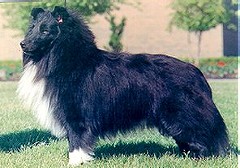|
Black in the sheltie is displayed in two ways: either as tricolor (coupled with tan and white) or as a bicolor black, also known as biblack, which is black and white. Tricolors have brown markings over the eyes, on the cheeks, and on the legs. The amount, color, shade, and richness of the tan may vary. I believe the most desireable shade may be the rich mahogany brown coloring often seen in Dobermans, though I'm certainly not an expert in this particular area. Only brown eyes are permissible in any of the blacks. There is a color known as "Cryptic Blue" which appears to be a black, but is actually a blue as proved through breeding. This color may exhibit a blue eye. But then, if it did, the suspiscion that it was a blue would be more evident than cryptic. Occassionally black dogs with blue eyes are seen. Usually it's with one brown eye and one clear blue eye. You can see an example of this on the Non-Standard Colors page!
Thanks to Reidun Monsholm of Playtime Shelties, Norway for the following pictures. These two shelties are wonderful examples of English and Swedish types!
Edglonian Rather Dashing, English tri bitch
Ch. Gordon Bell Sensible Touch, Swedish tri dog
Thanks to Mark and Maureen Merlo of Realities Shelties for these exemplary shots of their biblack dog, Starhaven's Rock-On-Bi "Rocky".
Thanks to Marilyn Marlow of Cameo Shelties for this photo of her 1990 National winning biblack, Ch Cameo Total Eclipse "Bart". He's a very fine example of what a biblack can accomplish in the breed ring!
Go HOME
This page hosted by |
 The Color of Midnight
The Color of Midnight 





